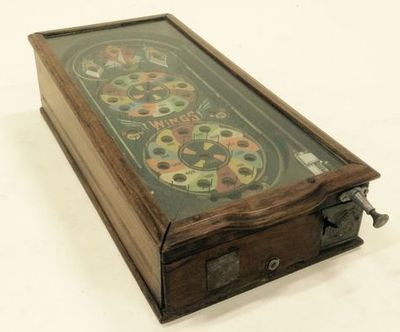 The first Pinball machine I acquired, after having owned a flipper for some years, more than 30 years ago (The 2-player Williams "Pretty Baby").
The first Pinball machine I acquired, after having owned a flipper for some years, more than 30 years ago (The 2-player Williams "Pretty Baby").
Before the invention of the flipper itself in 1947, most pinball machines had no external action, this one is different: the top disc (the bottom circle looks almost the same, but is stationary) spins when a new ball is pushed to the plunger, the rotating speed can be controlled by the player.
The rotating disc can even give the ball a kick, but that is not usually so. Most effect is that the maximum points are in a different location. For the rest, it is just the skill of how much speed the ball gets from the plunger. As with most pinball machines, the ball first makes a full circle around the playing field, before the real action starts. It has some nice cast-aluminium details in the playing field.
After 10 balls, the points must be counted by yourself, where of course the most important is the "double score" hole just below the top. My machine has 10 steel balls, but often these machines were provided with coloured balls, where the ball in the hole with the same colour would also score double.
Unluckily, the machine I have does not have the coin-machine any more. It has a knob at the rear which can be used to release the balls for a new game.


The very modern plunger, with scale to measure the spring loading, and the "Wings" cast-aluminium name "plate", which still has to be restored with original colours, blue, red and white.


Details of the playing field, with the rotating disc, the aluminium castings, and the "Double score" hole. Some stupid F&#k added some additional numbers... Still to be (carefully) removed.

Below: period advert pointing out all the advantages of this machine, and how much money you would make as an owner!
 The Rock-Ola Scale Company was founded in 1927 by David Cullen Rockola to manufacture coin-operated entertainment machines. During the 1920s, Rockola was linked with Chicago organized crime and escaped a jail sentence by turning State's Evidence. Mr. Rockola added the hyphen because people often mispronounced his name. The name was changed to Rock-Ola Manufacturing Corporation in 1932. The company successfully expanded its production line through the Great Depression to include furniture. Starting in 1935, Rock-Ola sold more than 400,000 jukeboxes under the Rock-Ola brand name, which predated the rock and roll era by two decades, and is thought to have inspired the term.
The Rock-Ola Scale Company was founded in 1927 by David Cullen Rockola to manufacture coin-operated entertainment machines. During the 1920s, Rockola was linked with Chicago organized crime and escaped a jail sentence by turning State's Evidence. Mr. Rockola added the hyphen because people often mispronounced his name. The name was changed to Rock-Ola Manufacturing Corporation in 1932. The company successfully expanded its production line through the Great Depression to include furniture. Starting in 1935, Rock-Ola sold more than 400,000 jukeboxes under the Rock-Ola brand name, which predated the rock and roll era by two decades, and is thought to have inspired the term.
Below, an example of an identical machine (not mine!), but restored to as-new (or better?) condition. This one also has the table, which could be ordered separately.


|


